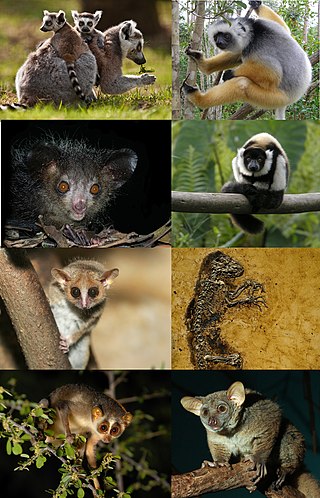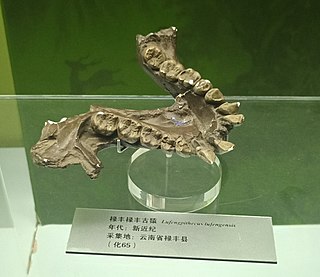
Strepsirrhini or Strepsirhini is a suborder of primates that includes the lemuriform primates, which consist of the lemurs of Madagascar, galagos ("bushbabies") and pottos from Africa, and the lorises from India and southeast Asia. Collectively they are referred to as strepsirrhines. Also belonging to the suborder are the extinct adapiform primates which thrived during the Eocene in Europe, North America, and Asia, but disappeared from most of the Northern Hemisphere as the climate cooled. Adapiforms are sometimes referred to as being "lemur-like", although the diversity of both lemurs and adapiforms does not support this comparison.

Haplorhini, the haplorhines or the "dry-nosed" primates is a suborder of primates containing the tarsiers and the simians, as sister of the Strepsirrhini ("moist-nosed"). The name is sometimes spelled Haplorrhini. The simians include catarrhines, and the platyrrhines.

The simians, anthropoids, or higher primates are an infraorder of primates containing all animals traditionally called monkeys and apes. More precisely, they consist of the parvorders Platyrrhini and Catarrhini, the latter of which consists of the family Cercopithecidae and the superfamily Hominoidea.

Aegyptopithecus is an early fossil catarrhine that predates the divergence between hominoids (apes) and cercopithecids. It is known from a single species, Aegyptopithecus zeuxis, which lived around 38-29.5 million years ago in the early part of the Oligocene epoch. It likely resembled modern-day New World monkeys, and was about the same size as a modern howler monkey, which is about 56 to 92 cm long. Aegyptopithecus fossils have been found in the Jebel Qatrani Formation of modern-day Egypt. Aegyptopithecus is believed to be a stem-catarrhine, a crucial link between Eocene and Miocene fossils.

Archaeoindris fontoynontii is an extinct giant lemur and the largest primate known to have evolved on Madagascar, comparable in size to a male gorilla. It belonged to a family of extinct lemurs known as "sloth lemurs" (Palaeopropithecidae) and, because of its extremely large size, it has been compared to the ground sloths that once roamed North and South America. It was most closely related to Palaeopropithecus, the second largest type of sloth lemur. Along with the other sloth lemurs, Archaeoindris was related to the living indri, sifakas, and woolly lemurs, as well as the recently extinct monkey lemurs (Archaeolemuridae). The genus, Archaeoindris, translates to "ancient indri-like lemur", even though it probably became extinct recently, around 350 BCE.

Eosimias is a genus of early primates, first discovered and identified in 1999 from fossils collected in the Shanghuang fissure-fillings of Liyang, the southern city of Jiangsu Province, China. It is a part of the family Eosimiidae, and includes three known species: Eosimias sinensis, Eosimias centennicus, and Eosimias dawsonae. It provides us with a glimpse of a primate skeleton similar to that of the common ancestor of the Haplorhini. The name Eosimias is designed to mean "dawn monkey", from Greek eos "dawn" and Latin simius "monkey".

Victoriapithecus macinnesi was a primate from the middle Miocene that lived approximately 15 to 17 million years ago in Northern and Eastern Africa. Through extensive field work on Maboko Island in Lake Victoria, Kenya, over 3,500 specimens have been found, making V. macinnesi one of the best-known fossil primates. It was previously thought that perhaps multiple species of Victoriapithecus were found, however the majority of fossils found indicate there is only one species, V. macinnesi. Victoriapithecus shows similarities to the extant subfamilies Colobinae and Cercopithecinae. However, Victoriapithecus predates the last common ancestor of these two groups and instead is thought to be a sister taxon.

Lufengpithecus is an extinct genus of ape, known from the Late Miocene of East Asia. It is known from thousands of dental remains and a few skulls and probably weighed about 50 kg (110 lb). It contains three species: L. lufengensis, L. hudienensis and L. keiyuanensis. Lufengpithecus lufengensis is from the Late Miocene found in China, named after the Lufeng site and dated around 6.2 Ma. Lufengpithecus is either thought to be the sister group to Ponginae, or the sister to the clade containing Ponginae and Homininae.
Rooneyia viejaensis is a relatively small primate belonging to the extinct monotypic genus Rooneyia. Rooneyia viejaensis is known from the North American Eocene of the Sierra Vieja of West Texas; the species is only known from the type specimen. The lack of additional fossils at this time makes it difficult to hypothesize where and how Rooneyia may have evolved. The minimal wear upon the molar teeth of the specimen has led to the assumption that the type specimen is that of a young adult. Rooneyia does not consistently fall within any one group of fossil or extant primates.
Algeripithecus is an extinct genus of early fossil primate, weighing approximately 65 to 85 grams. Fossils have been found in Algeria dating from 50 to 46 million years ago.
Biretia is an extinct genus of Old World monkey belonging to the extinct family Parapithecidae. Fossils are found from Late Eocene strata in Egypt.

Saadanius is a genus of fossil primates dating to the Oligocene that is closely related to the common ancestor of the Old World monkeys and apes, collectively known as catarrhines. It is represented by a single species, Saadanius hijazensis, which is known only from a single partial skull tentatively dated between 29 and 28 million years ago. It was discovered in 2009 in western Saudi Arabia near Mecca and was first described in 2010 after comparison with both living and fossil catarrhines.
Plesiopithecus is an extinct genus of early strepsirrhine primate from the late Eocene.

Pappocetus is an extinct protocetid cetacean known from the Eocene of Nigeria and Togo.

Amphipithecus mogaungensis was a primate that lived in Late Eocene Myanmar. Along with another primate Pondaungia cotteri, both are difficult to categorise within the order Primates. What little is known suggests that they are neither adapiform nor omomyid primates, two of the earliest primate groups to appear in the fossil record. Deep mandibles and mandibular molars with low, broad crowns suggest they are both simians, a group that includes monkeys, apes, and humans, though more material is needed for further comparison. The teeth also suggest that these were frugivore primates, with a body mass of 6–10 kg (13–22 lb).
Afradapis is a genus of adapiform primate that lived during the Late Eocene. The only known species, Afradapis longicristatus, was discovered in the Birket Qarun Formation in northern Egypt in 2009. While its geographic distribution is confined to Afro-Arabia, Afradapis belongs to the predominantly European adapiform family Caenopithecinae. This taxonomic placement is supported by recent phylogenetic analyses that recover a close evolutionary relationship between Afradapis and adapiforms, including Darwinius. While adapiforms have been noted for their strepsirrhine-like morphology, no adapiform fossil possesses the unique anatomical traits to establish an ancestor-descent relationship between caenopithecids and living strepsirrhines. It ate leaves and moved around slowly like lorises.

Pliopithecoidea is an extinct superfamily of catarrhine primates that inhabited Asia and Europe during the Miocene. Although they were once a widespread and diverse group of primates, the pliopithecoids have no living descendants.
The Amphipithecidae were simian primates that lived in Late Eocene and Early Oligocene. Fossils have been found in Myanmar, Thailand, and Pakistan. The limited fossil evidence is consistent with, but not exclusive to, arboreal quadrupedalism. In other words, the species may have moved about in trees on four legs, but not with regular leaping as seen in later simians.
Proteopithecidae is an extinct family of primates which lived in the Priabonian and probably early Oligocene periods. Fossils that have been found are in the Jebel Qatrani Formation in Egypt. Currently two genera are recognised, each with a single species, those being Proteopithecus sylviae and Serapia eocaena.
Micropithecus is an extinct genus of primates that lived in East Africa about 19 to 15 million years ago, during the early Miocene. The genus and its type species, Micropithecus clarki, were first scientifically described in 1978.
















